What Are Some Animals That Have Gone Extinct
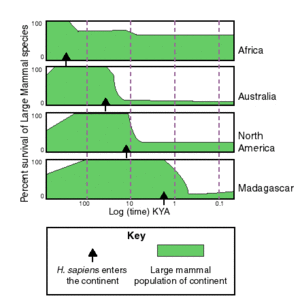
Biodiversity of large mammal species per continent before and later humans' arrival

- Extinct in the wild (EW): 2 species
- Critically endangered (CR): 203 species
- Endangered (EN): 505 species
- Vulnerable (VU): 536 species
- Well-nigh threatened (NT): 345 species
- Least concern (LC): 3,306 species
- Data deficient (DD): 872 species
Mammalian species (IUCN, 2020-1)
- 5850 extant species take been evaluated
- 4978 of those are fully assessed[a]
- 3651 are not threatened at present[b]
- 1244 to 2116 are threatened[c]
- 81 to 83 are extinct or extinct in the wild:
- 81 extinct (EX) species[d]
- 2 extinct in the wild (EW)
- 0 possibly extinct [CR(PE)]
- 0 possibly extinct in the wild [CR(PEW)]
Recently extinct mammals are defined by the International Matrimony for Conservation of Nature (IUCN) every bit any mammals that have become extinct since the year 1500 CE.[1] Since then, roughly 80 mammal species have get extinct.[ii]
Extinction of taxa is hard to confirm, as a long gap without a sighting is non definitive, but before 1995 a threshold of fifty years without a sighting was used to declare extinction.[one]
One study found that extinction from habitat loss is the hardest to detect, as this might but fragment populations to the point of concealment from humans. Some mammals declared as extinct may very well reappear.[1] For example, a report constitute that 36% of purported mammalian extinction had been resolved, while the rest either had validity issues (insufficient evidence) or had been rediscovered.[three]
As of December 2015, the IUCN listed thirty mammalian species as "critically endangered (possibly extinct)".[iv]
Conventions [edit]
All species listed as "Extinct" are classified as being extinct (no known remaining individuals left) by the International Union for Conservation of Nature (IUCN). All species listed as Extinct in the wild are classified as being extinct in the wild, significant that all remaining individuals of the species reside in captivity. All species listed as "Possibly extinct" are classified as beingness critically endangered, as information technology is unknown whether or non these species are extinct.[five] Extinct subspecies such as the Javan tiger (Panthera tigris sondaica)[6] are non listed here as the species, in this case Panthera tigris, is withal extant. The IUCN Redlist classification for each species serves as a citation, and the superscripted "IUCN" by the date is a link to that species' folio. A range map is provided wherever available, and a description of their old or current range is given if a range map is not available.
Causes of extinction [edit]
Habitat deposition is currently the master anthropogenic cause of species extinctions. The primary crusade of habitat degradation worldwide is agriculture, with urban sprawl, logging, mining and some fishing practices shut backside. The physical devastation of a habitat, both direct (deforestation for land evolution or lumber) and indirectly (burning fossil fuels), is an example of this.[seven] [eight]
As well, increasing toxicity, through media such equally pesticides, tin can kill off a species very apace, past killing all living members through contamination or sterilizing them. Persistent organic pollutants (POPs), for example, can bioaccumulate to hazardous levels, getting increasingly more than unsafe farther up the food chain.[9]
Affliction can likewise be a cistron: white nose syndrome in bats, for example, is causing a substantial decline in their populations and may even pb to the extinction of a species.[10]
Overhunting besides has an bear on. Terrestrial mammals, such every bit the tiger and deer, are mainly hunted for their pelts and in some cases meat, and marine mammals can exist hunted for their oil and leather. Specific targeting of one species tin can be problematic to the ecosystem because the sudden demise of one species can inadvertently lead to the demise of another (coextinction) especially if the targeted species is a keystone species. Ocean otters, for example, were hunted in the maritime fur trade, and their drop in population led to the rise in sea urchins—their main nutrient source—which decreased the population of kelp—the body of water urchin's and Steller's sea cow'south main food source—leading to the extinction of the Steller's ocean cow.[11] The hunting of an already limited species tin can easily lead to its extinction, as with the bluebuck whose range was confined to one,700 square miles (4,400 km2) and which was hunted into extinction soon afterward discovery by European settlers.[12]
Commonwealth of australia [edit]
Isle creatures are usually owned to only that island, and that express range and small population tin can leave them vulnerable to sudden changes.[13] While Commonwealth of australia is a continent and not an isle, due to its geographical isolation, its unique fauna has suffered an extreme turn down in mammal species, x% of its 273 terrestrial mammals, since European settlement (a loss of 1 to ii species per decade); in contrast, only one species in Northward America has get extinct since European settlement. Furthermore, 21% of Commonwealth of australia's mammals are threatened, and unlike in nigh other continents, the main cause is predation past feral species, such as cats.[14]
Extinct species [edit]
A species is declared extinct after exhaustive surveys of all potential habitats eliminate all reasonable uncertainty that the last private of a species, whether in the wild or in captivity, has died.[fifteen] Recently extinct species are defined by the IUCN as becoming extinct after 1500 CE.[ane]
| Common name | Binomial name | Society | Date of extinction | Former range | Picture |
|---|---|---|---|---|---|
| Broad-faced potoroo | Potorous platyops Gould, 1844 | Diprotodontia | 1875 1 | Commonwealth of australia | 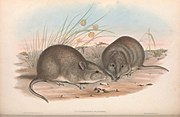 |
| Eastern hare wallaby | Lagorchestes leporides Gould, 1841 | Diprotodontia | 1889 ane | 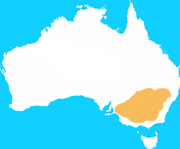 Australia |  |
| Lake Mackay hare-wallaby | Lagorchestes asomatus Finlayson, 1943 | Diprotodontia | 1932 i | Commonwealth of australia | |
| Desert rat-kangaroo | Caloprymnus campestris Gould, 1843 | Diprotodontia | 1935 i |  Australia | 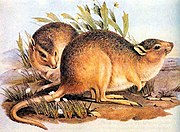 |
| Thylacine, or Tasmanian wolf/tiger | Thylacinus cynocephalus Harris, 1808 | Dasyuromorphia | 1936 1 |  Australia, Tasmania |  |
| Toolache wallaby | Macropus greyi Waterhouse, 1846 | Diprotodontia | 1939 1 | Australia |  |
| Desert bandicoot | Perameles eremiana Spencer, 1837 | Peramelemorphia | 1943 1 | Australia | 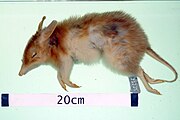 |
| New South Wales barred bandicoot[16] | Perameles fasciata Grey, 1841 | Peramelemorphia | mid-19th century | Australia | 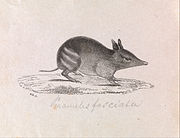 |
| Southwestern barred bandicoot[xvi] | Perameles myosuros Wagner, 1841 | Peramelemorphia | mid-19th century | Commonwealth of australia |  |
| Southern barred bandicoot[16] | Perameles notina Thomas, 1922 | Peramelemorphia | mid-19th century | Australia | |
| Ooldea barred bandicoot[xvi] | Perameles papillon Travouillon & Phillips, 2018 | Peramelemorphia | early 20th century | Australia | |
| Lesser bilby, or Yallara | Macrotis leucura Thomas, 1887 | Peramelemorphia | 1960s 1 |  Australia |  |
| Southern pig-footed bandicoot | Chaeropus ecaudatus Ogilby, 1838 | Peramelemorphia | 1950s i | 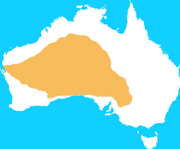 Australia | 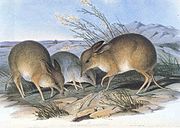 |
| Northern pig-footed bandicoot | Chaeropus yirratji Travouillon et al., 2019 | Peramelemorphia | 1950s |  |  |
| Crescent blast-tail wallaby | Onychogalea lunata Gould, 1841 | Diprotodontia | 1956 1 | Australia (western and cardinal) |  |
| Red-bellied gracile opossum, or cerise-bellied gracile mouse opossum | Cryptonanus ignitus Díaz, Flores and Barquez, 2002 | Didelphimorphia | 1962 1 | Argentina | |
| Nullarbor dwarf bettong | Bettongia pusilla McNamara, 1997 | Diprotodontia | early 1500s 1 | Australia (Nullarbor Plain) | |
| Steller'south sea moo-cow | Hydrodamalis gigas von Zimmermann, 1780 | Sirenia | 1768 1 | Commander Islands (Russia, United States) |  |
| Bramble Cay melomys | Melomys rubicola Thomas, 1924 | Rodentia | 2016 ane | Australia (Bramble Cay) |  |
| Oriente cavern rat | Boromys offella Miller, 1916 | Rodentia | early 1500s 1 | Cuba | 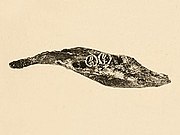 |
| Torre'south cave rat | Boromys torrei Allen, 1917 | Rodentia | early 1500s i | Republic of cuba | 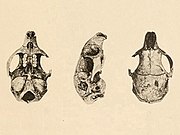 |
| Imposter hutia | Hexolobodon phenax Miller, 1929 | Rodentia | early on 1500s one | Hispaniola (currently Haiti and the Dominican Commonwealth) | |
| Montane hutia | Isolobodon montanus Miller, 1922 | Rodentia | early 1500s i | Hispaniola | |
| Dwarf viscacha | Lagostomus crassus Thomas, 1910 | Rodentia | early 1900s 1 | Republic of peru | |
| Galápagos giant rat | Megaoryzomys curioi Niethammer, 1964 | Rodentia | 1500s 1 | Santa Cruz Island (Galápagos) | 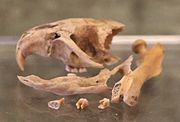 |
| Cuban coney | Geocapromys columbianus Chapman, 1892 | Rodentia | early on 1500s 1 | Cuba | |
| Hispaniolan edible rat | Brotomys voratus Miller, 1916 | Rodentia | 1536–1546 1 | Hispaniola | |
| Puerto Rican hutia | Isolobodon portoricensis Allen, 1916 | Rodentia | early 1900s 1 | Hispaniola; introduced to Puerto Rico, Saint Thomas Island, Saint Croix, U.Southward. Virgin Islands and Mona Island | |
| Big-eared hopping mouse | Notomys macrotis Thomas, 1921 | Rodentia | 1843 i | Australia (primal Western Commonwealth of australia) | |
| Darling Downs hopping mouse | Notomys mordax Thomas, 1921 | Rodentia | 1846 i | Australia (Darling Downs, Queensland) | |
| White-footed rabbit-rat | Conilurus albipes Lichtenstein, 1829 | Rodentia | early 1860s 1 | Commonwealth of australia (eastern coast) |  |
| Capricorn rabbit rat | Conilurus capricornensis Cramb and Hocknull, 2010 | Rodentia | early on 1500s i | Commonwealth of australia (Queensland) | |
| Brusk-tailed hopping mouse | Notomys amplus Brazenor, 1936 | Rodentia | 1896 ane | Australia (Great Sandy Desert) | |
| Long-tailed hopping mouse | Notomys longicaudatus Gould, 1844 | Rodentia | 1901 1 | Australia | |
| Keen hopping mouse | Notomys robustus Mahoney, Smith and Medlin, 2008 | Rodentia | mid-1800s 1 | Australia (Flinders and Davenport Ranges) | |
| Desmarest'south pilorie, or Martinique giant rice rat | Megalomys desmarestii Fischer, 1829 | Rodentia | 1902 1 | Martinique |  |
| Saint Lucia pilorie, or Saint Lucia giant rice rat | Megalomys luciae Major, 1901 | Rodentia | 1881 1 | Saint Lucia |  |
| Bulldog rat | Rattus nativitatis Thomas, 1888 | Rodentia | 1903 one | Christmas Island |  |
| Maclear's rat | Rattus macleari Thomas, 1887 | Rodentia | 1903 1 | Christmas Island |  |
| Darwin's Galápagos mouse | Nesoryzomys darwini Osgood, 1929 | Rodentia | 1930 i | Galápagos Islands | |
| Gould'south mouse | Pseudomys gouldii Waterhouse, 1839 | Rodentia | 1930 1 | Australia (southern half) |  |
| Plains rat, or Palyoora | Pseudomys auritus Thomas, 1910 | Rodentia | early 1800s 1 | Australia (Kangaroo Island and the Younghusband Peninsula) | |
| Pemberton'southward deer mouse | Peromyscus pembertoni Burt, 1932 | Rodentia | 1931 ane | San Pedro Nolasco Island, Mexico | |
| Samaná hutia | Plagiodontia ipnaeum Johnson, 1948 | Rodentia | early on 1500s [a] i | Hispaniola | |
| Hispaniola monkey | Antillothrix bernensis MacPhee, Horovitz, Arredondo, & Jimenez Vasquez, 1995 | Primates | early 16th century | Hispaniola (currently Dominican Republic) | |
| Lesser stick-nest rat, or white-tipped stick-nest rat | Leporillus apicalis John Gould, 1854 | Rodentia | 1933 one | Australia (due west-cardinal) |  |
| Indefatigable Galápagos mouse | Nesoryzomys indefessus Thomas, 1899 | Rodentia | 1934 ane | Galápagos Islands | |
| Little Swan Island hutia | Geocapromys thoracatus True, 1888 | Rodentia | 1955 1 | Swan Islands, Republic of honduras | 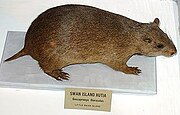 |
| Blue-greyness mouse | Pseudomys glaucus Thomas, 1910 | Rodentia | 1956 i | Australia (Queensland, New South Wales) | |
| Buhler's coryphomys or Buhler's rat | Coryphomys buehleri Schaub, 1937 | Rodentia | early 1500s i | W Timor, Republic of indonesia | |
| Insular cavern rat | Heteropsomys insulans Anthony, 1916 | Rodentia | early 1500s 1 | Vieques Isle, Puerto Rico | |
| Candango mouse | Juscelinomys candango Moojen, 1965 | Rodentia | 1960 1 | Key Brazil | |
| Anthony's woodrat | Neotoma anthonyi Allen, 1898 | Rodentia | 1926 1 | Isla Todos Santos, Mexico | |
| Bunker'south woodrat | Neotoma bunkeri Burt, 1932 | Rodentia | 1931 1 | Coronado Islands, United mexican states | |
| Vespucci'south rodent | Noronhomys vespuccii Carleton and Olson, 1999 | Rodentia | 1500 1 | Fernando de Noronha, Brazil | |
| St. Vincent colilargo, or St. Vincent pygmy rice rat | Oligoryzomys victus Thomas, 1898 | Rodentia | 1892 i | Saint Vincent | |
| Jamaican rice rat | Oryzomys antillarum Thomas, 1898 | Rodentia | 1877 1 | Jamaica |  |
| Nelson'southward rice rat | Oryzomys nelsoni Merriam, 1889 | Rodentia | 1897 1 | Islas Marías, Mexico |  |
| Nevis rice rat, or St. Eustatius rice rat, St. Kitts rice rat | Pennatomys nivalis Turvey, Weksler, Morris, and Nokkert, 2010 | Rodentia | early 1500s [b] one | Sint Eustatius and Saint Kitts and Nevis | 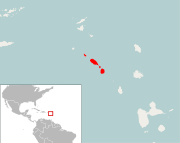 |
| Christmas Isle pipistrelle | Pipistrellus murrayi Andrews, 1900 | Chiroptera | 2009 ane | Christmas Island | |
| Sardinian pika | Prolagus sardus Wagner, 1832 | Lagomorpha | 1774 1 | Corsica and Sardinia |  |
| Marcano's solenodon | Solenodon marcanoi Patterson, 1962 | Eulipotyphla | 1500s 1 | Dominican Republic | |
| Puerto Rican nesophontes | Nesophontes edithae Anthony, 1916 | Eulipotyphla | early 1500s 1 | Puerto Rico, Vieques Island, Saint John, U.Due south. Virgin Islands, and Saint Thomas, U.S. Virgin Islands |  |
| Atalaye nesophontes | Nesophontes hypomicrus Miller, 1929 | Eulipotyphla | early 1500s 1 | Hispaniola | |
| Greater Cuban nesophontes | Nesophontes major Arredondo, 1970 | Eulipotyphla | early 1500s i | Republic of cuba | |
| Western Cuban nesophontes | Nesophontes micrus Allen, 1917 | Eulipotyphla | early on 1500s 1 | Cuba (including Isla de la Juventud) | |
| St. Michel nesophontes | Nesophontes paramicrus Miller, 1929 | Eulipotyphla | early 1500s 1 | Hispaniola | |
| Haitian nesophontes | Nesophontes zamicrus Miller, 1929 | Eulipotyphla | early on 1500s one | Republic of haiti | |
| Bottom Mascarene flying fox, or dark flying pull a fast one on | Pteropus subniger kerr, 1792 | Chiroptera | 1864 1 | Réunion, Mauritius |  |
| Guam flying pull a fast one on, or Guam fruit bat | Pteropus tokudae Tate, 1934 | Chiroptera | 1968 1 | Guam | |
| Dusky flying play a joke on, or Percy Island flying play a trick on | Pteropus brunneus Dobson, 1878 | Chiroptera | 1870 one | Percy Islands (Australia) | |
| Large Palau flying fox | Pteropus pilosus Andersen, 1908 | Chiroptera | 1874 1 | Palau | |
| Big sloth lemur | Palaeopropithecus ingens Grandidier, 1899 | Primate | 1620 i |  In green | 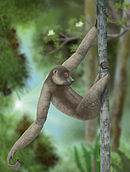 |
| Aurochs | Bos primigenius Bojanus, 1827 | Artiodactyla | 1627 1 |  |  |
| Bluebuck | Hippotragus leucophaeus Pallas, 1766 | Artiodactyla | 1800 1 |  |  |
| Red gazelle | Eudorcas rufina Thomas, 1894 | Artiodactyla | belatedly 1800s 1 | Algeria |  |
| Schomburgk's deer | Rucervus schomburgki Blyth, 1863 | Artiodactyla | 1932 1 | Thailand |  |
| Queen of Sheba'south gazelle, or Yemen gazelle | Gazella bilkis Grover and Lay, 1985 | Artiodactyla | 1951 ane | Yemen | |
| Madagascan dwarf hippopotamus | Hippopotamus lemerlei Milne-Edwards, 1868 | Artiodactyla | early 1500s [c] i | Madagascar |  |
| Falkland Islands wolf or warrah | Dusicyon australis Kerr, 1792 | Carnivora | 1876 i | Falkland Islands | 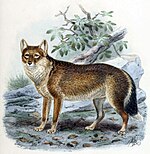 |
| Burmeister's fox | Dusicyon avus Burmeister, 1866 | Carnivora | early 1500s 1 | Argentine republic, Chile, Brazil, Uruguay, Paraguay | |
| Sea mink | Neogale macrodon Prentiss, 1903 | Carnivora | 1894 1 | United States (Maine, Massachusetts) and Canada (New Brunswick, Newfoundland) | |
| Japanese bounding main lion | Zalophus japonicus Peters, 1866 | Carnivora | 1970s 1 | Nihon, Korea, Russia |  |
| Caribbean area monk seal | Neomonachus tropicalis Grey, 1850 | Carnivora | 1952 ane | Caribbean area Body of water |  |
| Giant fossa | Cryptoprocta spelea Grandidier, 1902 | Carnivora | before 1658 1 |  |  |
Extinct in the wild [edit]
A species that is extinct in the wild is i which has been categorized past the International Spousal relationship for Conservation of Nature (IUCN) as only known by living members kept in captivity or as a naturalized population outside its historic range due to massive habitat loss. A species is declared extinct in the wild later thorough surveys accept inspected its historic range and failed to find testify of a surviving individual.[fifteen]
| Mutual proper name | Binomial proper noun | Order | Date of extinction | Former range | Picture |
|---|---|---|---|---|---|
| Père David's deer | Elaphurus davidianus Milne-Edwards, 1866 | Artiodactyla | 1939 1 | China |  |
| Scimitar oryx | Oryx dammah Cretzschmar, 1827 | Artiodactyla | 2000 ane | Sahara Desert |  |
Possibly extinct [edit]
Extinction of taxa is hard to notice, as a long gap without a sighting is not definitive. Some mammals declared as extinct may very well reappear.[one] For example, a report establish that 36% of purported mammalian extinction had been resolved, while the rest either had validity issues (bereft evidence) or had been rediscovered.[3] As of December 2015, the IUCN listed 30 mammalian species as "critically endangered (possibly extinct)".[4]
| Common name | Binomial name | Order | Last confirmed sighting | Range | Picture show |
|---|---|---|---|---|---|
| Kouprey, or Wood ox | Bos sauveli Urbain, 1937 | Artiodactyla | 1988 1 |  | |
| Garrido's hutia | Capromys garridoi Varona, 1970 | Rodentia | 1989 ane [ dead link ] | Cayo Maja, Cuba | |
| Christmas Isle shrew | Crocidura trichura Dobson, 1889 | Eulipotyphla | 1985 1 | 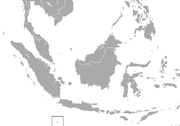 | |
| Wimmer's shrew | Crocidura wimmeri de Balsac and Aellen, 1958 | Eulipotyphla | 1976 1 |  | |
| De Winton'southward golden mole | Cryptochloris wintoni Broom, 1907 | Eulipotyphla | 1937 1 |  | |
| Fuegian dog | Lycalopex culpaeus Bridges, 1919 | Lycalopex | 1919 1 | Argentina | 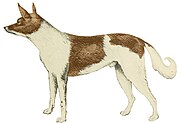 |
| Baiji, or Yangtze river dolphin | Lipotes vexillifer Miller, 1918 | Cetacea | 2002 [d] i |  |  |
| Zuniga's nighttime rice rat | Melanomys zunigae Sanborn | Rodentia | 1949 1 | Peru | |
| Dwarf hutia | Mesocapromys nanus Allen, 1917 | Rodentia | 1937 one | Ciénaga de Zapata, Republic of cuba | |
| San Felipe hutia, or Trivial globe hutia | Mesocapromys sanfelipensis Varona & Garrido, 1970 | Rodentia | 1978 1 | Cuba | |
| One-striped opossum | Monodelphis unistriata Wagner, 1842 | Didelphimorphia | 1899 1 | 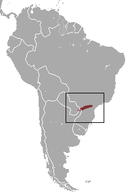 | |
| Gloomy tube-nosed bat | Murina tenebrosa Yoshiyuki, 1970 | Chiroptera | 1962 ane | Tsushima Island and maybe Yaku Island, Japan | |
| New Zealand greater short-tailed bat | Mystacina robusta Dwyer, 1962 | Chiroptera | 1967 1 | Big South Cape Island, New Zealand |  |
| Ethiopian amphibious rat, or Ethiopian water mouse | Nilopegamys plumbeus Osgood, 1928 | Rodentia | 1920s 1 | Mouth of the Lesser Abay River, Federal democratic republic of ethiopia | |
| Lord Howe long-eared bat | Nyctophilus howensis McKean, 1975 | Chiroptera | 1972 1 | Lord Howe Isle, Australia | |
| Angel Island mouse | Peromyscus guardia Townsend, 1912 | Rodentia | 1991 i | Isla Ángel de la Guarda, Mexico | |
| Puebla deer mouse | Peromyscus mekisturus Merriam, 1898 | Rodentia | 1950s one | Ciudad Serdan and Tehuacán, United mexican states | |
| Telefomin cuscus | Phalanger matanim Flannery, 1987 | Diprotodontia | 1997 1 |  | |
| Montane monkey-faced bat | Pteralopex pulchra Flannery, 1991 | Chiroptera | 1990s 1 |  | |
| Aru flying fox | Pteropus aruensis Peter, 1867 | Chiroptera | 1877 one |  | |
| Emma'south behemothic rat | Uromys emmae Groves and Flannery, 1994 | Rodentia | 1990s ane | Papua Province, Indonesia | |
| Emperor rat | Uromys imperator Thomas, 1888 | Rodentia | 1888 1 | Guadalcanal, Solomon Islands | |
| Guadalcanal rat | Uromys porculus Thomas, 1904 | Rodentia | 1888 1 | Guadalcanal, Solomon Islands | |
| Central rock rat | Zyzomys pedunculatus Waite, 1896 | Rodentia | 2001 [e] one |  |  |
| Malabar large-spotted civet, or Malabar civet | Viverra civettina Blyth, 1862 | Carnivora | late 1900s [f] one |  |
Encounter also [edit]
- Holocene extinction
- Listing of extinct animals
- List of extinct birds
- Lists of mammals by population
Notes [edit]
- ^ A 1985 study suggested they may have survived into the 1900s based on local legends of the "comadreja"
- ^ At that place were reports of unusual rats on Nevis being eaten by islanders in the 1930s.[17]
- ^ Although, 14C dating points their extinction at 1000 C. E., a 1991 study establish they coexisted with humans and survived into the 1500s.[18]
- ^ The species may exist functionally extinct.[nineteen]
- ^ The species was presumed extinct until information technology was rediscovered in 1996. There was a possible discovery in 2015.[20]
- ^ The terminal confirmed sighting is unknown and their range in the wild is unconfirmed. Camera traps in Karnataka, their presumed habitat, plant no individuals after 1,084 nights in 2006.[21]
References [edit]
- ^ a b c d e Fisher, Diana O.; Blomberg, Simon P. (2011). "Correlates of rediscovery and the detectability of extinction in mammals". Proceedings of the Royal Society B: Biological Sciences. 278 (1708): 1090–1097. doi:ten.1098/rspb.2010.1579. PMC3049027. PMID 20880890.
- ^ Ceballos, G.; Ehrlich, A. H.; Ehrlich, P. R. (2015). The Annihilation of Nature: Human Extinction of Birds and Mammals. Baltimore, Maryland: Johns Hopkins Academy Press. ISBN 1421417189. "69"
- ^ a b Macphee, Ross D. E.; Flemming, Clare (1999). "Requiem Æternam: the terminal 5 hundred years of mammalian species extinctions". In MacPhee, Ross D. Eastward.; Sues, Hans-Dieter (eds.). Extinctions in Most Time. Advances in Vertebrate Paleobiology. Vol. 2. ISBN978-ane-4419-3315-7.
- ^ a b "IUCN Red List version 2015.4". The IUCN Ruby List of Threatened Species. International Spousal relationship for Conservation of Nature and Natural Resources (IUCN). Retrieved 3 December 2015.
- ^ "Mayhap Extinct and Perchance Extinct in the Wild Species" (PDF). IUCN Redlist of Threatened Species. 2016. Retrieved 29 August 2016.
- ^ Jackson, P.; Nowell, K. (2008). "Panthera tigris ssp. sondaica". IUCN Red Listing of Threatened Species. 2008: e.T41681A10509194. doi:10.2305/IUCN.UK.2008.RLTS.T41681A10509194.en . Retrieved 12 November 2021.
- ^ Primack, R. B. (2006). "Habitat destruction". Essentials of Conservation Biological science (4th ed.). Sunderland, MA.: Sinauer Assembly. pp. 177–188. ISBN978-0-87893-720-two.
- ^ Winkelmann, Ricarda; Levermann, Anders; Ridgwell, Andy; Caldeira, Ken (2015). "Combustion of bachelor fossil fuel resources sufficient to eliminate the Antarctic Ice Sheet". Science Advances. i (viii): e1500589. Bibcode:2015SciA....1E0589W. doi:10.1126/sciadv.1500589. PMC4643791. PMID 26601273.
- ^ Kelly, B. C.; Ikonomou, Thou. G.; Blair, J. D.; Morin, A. E.; Gobas, F. A. P. C. (2007). "Food Web-Specific Biomagnification of Persistent Organic Pollutants". Science. 317 (5835): 236–239. Bibcode:2007Sci...317..236K. doi:ten.1126/scientific discipline.1138275. PMID 17626882. S2CID 52835862.
- ^ Langwig, Chiliad.E.; W.F. Frick; J.T. Bried; A.C. Hicks; T.H. Kunz; A.M. Kilpatrick (2012). "Sociality, density-dependence and microclimates decide the persistence of populations suffering from a novel fungal illness, white-nose syndrome". Ecology Messages. xv (i): 1050–1057. doi:10.1111/j.1461-0248.2012.01829.x. PMID 22747672.
- ^ Estes, James A.; Burdin, Alexander; Doak, Daniel F. (2016). "Body of water otters, kelp forests, and the extinction of Steller's sea cow". Proceedings of the National University of Sciences of the United states of america of America. 113 (4): 880–885. Bibcode:2016PNAS..113..880E. doi:10.1073/pnas.1502552112. PMC4743786. PMID 26504217.
- ^ Husson, A. Chiliad.; Holthuis, L. B. (1969). "On the type of Antilope leucophaea preserved in the collection of the Rijksmuseum van Natuurlijke Historie Leiden". Zoologische Mededelingen. 44: 147–157.
- ^ van der Geer, Alexandra; Lyras, George; de Vos, John; Dermitzakis, Michael (2010). Development of Island Mammals: Adaptation and Extinction of Placental Mammals on Islands. Oxford: Wiley-Blackwell. pp. 225–227. ISBN978-1-4051-9009-1.
- ^ Woinarskia, John C. Z.; Burbidge, Andrew A.; Harrison, Peter L. (2015). "Ongoing unraveling of a continental fauna: Decline and extinction of Australian mammals since European settlement" (PDF). Proceedings of the National Academy of Sciences of the United States of America. 112 (5): 4531–4540. Bibcode:2015PNAS..112.4531W. doi:10.1073/pnas.1417301112. PMC4403217. PMID 25675493.
- ^ a b IUCN Redlist Categories and Criteria (PDF) (2nd ed.). Gland, Switzerland: IUCN Species Survival Commission. 2012. ISBN978-2-8317-1435-six.
- ^ a b c d TRAVOUILLON, KENNY J.; PHILLIPS, MATTHEW J. (vii February 2018). "Full show analysis of the phylogenetic relationships of bandicoots and bilbies (Marsupialia: Peramelemorphia): reassessment of two species and clarification of a new species". Zootaxa. 4378 (2): 224. doi:ten.11646/zootaxa.4378.ii.three. ISSN 1175-5334.
- ^ Turvey, Samuel T.; Weksler, Marcelo; Morris, Elaine L.; Nokkert, Marker (2010). "Taxonomy, phylogeny, and diversity of the extinct Bottom Antillean rice rats (Sigmodontinae: Oryzomyini), with description of a new genus and species". Zoological Journal of the Linnean Social club. 160 (four): 748–772. doi:ten.1111/j.1096-3642.2009.00628.x.
- ^ MacPhee, R. D. Eastward.; Burney, David A. (1991). "Dating of modified femora of extinct dwarf Hippopotamus from Southern Madagascar: Implications for constraining man colonization and vertebrate extinction events". Journal of Archaeological Scientific discipline. xviii (6): 695–706. doi:10.1016/0305-4403(91)90030-S.
- ^ Turvey, Samuel T.; Pitman, Robert L.; Taylor, Barbara L.; Barlow, Jay; Akamatsu, Tomonari; Barrett, Leigh A.; Zhao, Xiujiang; Reeves, Randall R.; Stewart, Brent Due south.; Kexiong, Wang; Zhuo, Wei; Zhang, Xianfeng; Pusser, L. T.; Richlen, Michael; Brandon, John R.; Wang, Ding (2007). "First man-caused extinction of a cetacean species?". Biology Messages. iii (5): 537–540. doi:10.1098/rsbl.2007.0292. PMC2391192. PMID 17686754.
- ^ McDonald, Peters J.; Brittingham, Richie; Nano, C. E. M.; Paltridge, Rachel M. (2015). "A new population of the critically endangered central rock-rat (Zyzomys pedunculatus) discovered in the Northern Territory". Australian Mammalogy. 37: 97–100. doi:10.1071/AM14012.
- ^ Rao, S.; Ashraf, N. V. K.; Nixon, A. G. A. (2007). "Search for the Malabar Civet Viverra civettina in Karnataka and Kerala, India, 2006–2007". Small Carnivore Conservation. 37: half-dozen–10.
Source: https://en.wikipedia.org/wiki/List_of_recently_extinct_mammals
Posted by: mastersthearkly.blogspot.com

0 Response to "What Are Some Animals That Have Gone Extinct"
Post a Comment